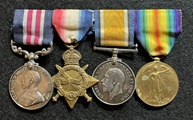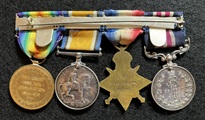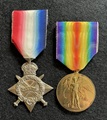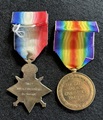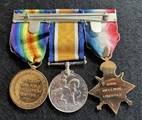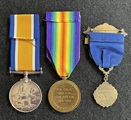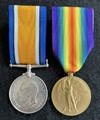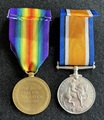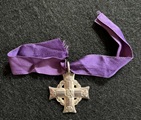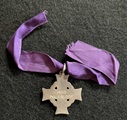One. Distinguished Conduct Medal (GV). Named to 13149 LCPL. J. SHARPLES. 2/COY CAN: M.G.C. John Sharples was born in Blackburn, England on 26 April 1896. He indicated his profession on enlistment as 'locomotive fireman'. After enlisting in Saskatoon, Saskatchewan, he attested into the 5th Battalion CEF on 21 September 1914 at Valcartier. His service record indicates that he had previously served in the 29th Light Horse, which was based in Saskatchewan; he had also served for 2 years in the British Army, as a member of the 2nd Volunteer Battalion of the East Lancashire Regiment. Sharples joined the 5th Bn in France on 14 May 1915, and served with the latter unit until he was transferred to the 2nd Canadian Infantry Brigade Machine Gun Company on 20 June 1916. Accidentally wounded on 11 September 1916, when he tripped in a trench near Pozieres after cleaning his machine gun, and impaled himself with a cleaning rod that went through the side of his face, he rejoined his unit on 18 November. Sharples was promoted to Lance Corporal on 11 May 1917. Wounded by a gas shell in mid-August 1917 (likely at the battle of Hill 70), Sharples was hospitalized with shrapnel wounds to his hand and the effects of gassing. He rejoined his unit again by 3 October 1917, and was back in action during the battle of Passchendaele, where his gallantry resulted in the award of the Distinguished Conduct Medal, which was published in London Gazette on 28 March 1918. His citation states:
For conspicuous gallantry and devotion to duty in action. Early in the day he was left alone with his gun, the remainder of his crew becoming casualties. He mounted it in a commanding position, and kept it in action throughout two whole days, and until he himself became a casualty, and was removed suffering from a concussion.
Sharples service file indicates that he received his concussion wound, as well as a wound to his right thigh, in action on 11 November 1917, which suggests that his DCM was earned during the battle of Passchendaele between 9-11 November 1917. Sharples indicated his intent after discharge was to settle in Sutherland, Saskatchewan. He was discharged from the CEF on 8 May 1919 in Toronto. Medal is on clean original ribbon, and is unmounted. An excellent gallantry award for the Battle of Passchendaele to a twice-wounded soldier from Saskatchewan, one of only 1984 awards of the DCM to the CEF during the First World War.
Good VF Condition $2000
